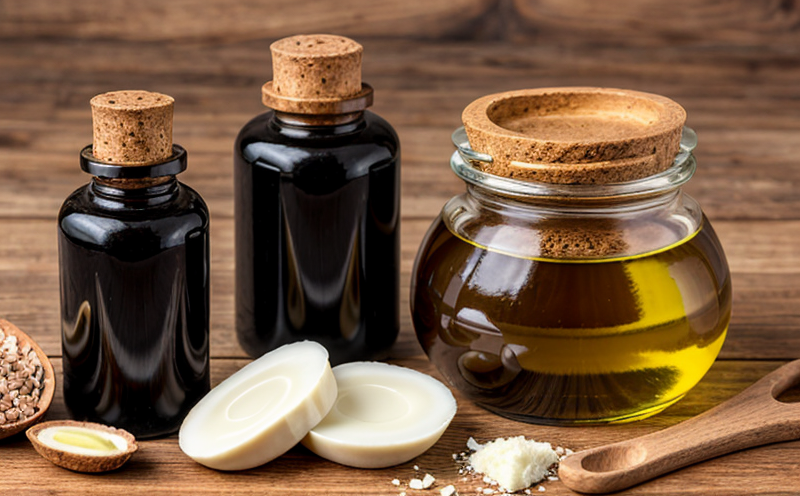ISO 16995 Chloropropanol (3-MCPD) Testing in Oils
The presence of chloropropanols, particularly 3-monochloropropane-1,2-diol (3-MCPD), is a critical concern for the food and feed industries. ISO 16995:2014 provides a standardized method for determining the content of 3-MCPD esters in oils and fats. This service ensures that your products comply with international safety standards, thus protecting consumer health.
Chloropropanols form during certain heat processing methods used to manufacture food items like soy sauce, soups, and other condiments. They are known carcinogens and neurotoxins, making their detection and quantification paramount in ensuring the safety of food products. This service helps you meet regulatory requirements set by organizations such as the European Food Safety Authority (EFSA), United States Food and Drug Administration (FDA), and World Health Organization (WHO).
The testing process involves several steps that are critical to achieving accurate results. Initially, the oil or fat sample is prepared according to ISO 16995 guidelines. This may include degumming, neutralization, and other treatments aimed at reducing interference from other compounds. The prepared sample is then analyzed using high-performance liquid chromatography (HPLC) with a tandem mass spectrometer (MS/MS) detector for accurate quantification.
The methodology outlined in ISO 16995 ensures that the results are reproducible and reliable, providing confidence in your product's safety. The service includes comprehensive documentation of all steps taken during sample preparation and analysis, which is essential for regulatory compliance. Our team of experts ensures that every aspect of the testing process adheres to international standards, ensuring accurate and precise results.
Our laboratory has extensive experience in conducting this type of testing across various industries, including food manufacturing, agricultural commodities, and pet food producers. By leveraging our expertise and state-of-the-art facilities, we can provide you with reliable data that supports your quality assurance programs and regulatory submissions.
The importance of ISO 16995 compliance extends beyond just meeting legal requirements. It also helps build consumer trust by demonstrating a commitment to product safety. In today’s competitive market, maintaining a positive brand reputation is crucial for long-term success. Our services not only help you comply with regulations but also enhance your brand image and customer confidence.
Why It Matters
The significance of detecting chloropropanols in oils cannot be overstated. Chloropropanols, including 3-MCPD esters, pose significant health risks when consumed in excess. These compounds have been linked to kidney damage and reproductive issues, among other potential hazards. By adhering to ISO 16995 standards, you can ensure that your products are safe for consumption.
Compliance with these regulations is not just a legal requirement; it also reflects a commitment to product quality and consumer safety. In today’s market, where transparency and accountability are increasingly valued by consumers, demonstrating adherence to international standards can be a powerful differentiator. It shows that you prioritize the well-being of your customers and take proactive steps to ensure their health.
Furthermore, meeting these standards can help prevent costly recalls and legal disputes. Consumers today demand more than just tasty products; they expect them to be safe for consumption. By ensuring that your products meet or exceed regulatory requirements, you protect yourself from potential lawsuits and negative publicity. This proactive approach not only reduces risks but also enhances your brand’s reputation.
Our laboratory offers a range of services designed specifically for the food and feed industry. From initial consultation to final report submission, we are committed to providing you with the highest quality service. Our team of experts works closely with you to understand your unique needs and challenges, ensuring that our solutions are tailored to meet them effectively.
Benefits
The benefits of ISO 16995 Chloropropanol (3-MCPD) Testing in Oils extend far beyond mere compliance; it offers a range of advantages that contribute significantly to the overall quality and safety of your products.
- Enhanced Consumer Confidence: Demonstrating adherence to rigorous testing protocols instills trust among consumers, helping build strong relationships with your customer base.
- Risk Management: By identifying potential issues early on in the production process, you can mitigate risks and ensure that only safe products reach the market.
- Competitive Edge: In an increasingly competitive global marketplace, maintaining high standards of quality sets your brand apart from competitors who may not prioritize such measures equally.
- Regulatory Compliance: Ensuring compliance with international standards helps avoid costly fines and penalties associated with non-compliance.
In addition to these tangible benefits, ISO 16995 Chloropropanol (3-MCPD) Testing in Oils supports broader goals related to corporate social responsibility. By prioritizing product safety and consumer health, you contribute positively towards sustainable development objectives.
Industry Applications
- Soybean Oil: Soybean oil is widely used in various food products such as frying oils, salad dressings, and margarines. Detecting 3-MCPD esters helps ensure these oils are safe for human consumption.
- Peanut Oil: Peanut oil is often utilized in snack foods like peanut butter and chips. Testing ensures that this popular food item remains free from harmful contaminants.
- Sunflower Oil: Sunflower oil is commonly used in baking, frying, and as a salad dressing ingredient. It’s crucial to test for 3-MCPD esters to maintain its quality standards.
- Corn Oil: Corn oil finds application in various food products including margarine spreads and cooking oils. Testing ensures that it meets the highest safety standards.
In summary, ISO 16995 Chloropropanol (3-MCPD) Testing in Oils plays a vital role across multiple sectors within the food industry. By implementing this testing procedure, you ensure your products are safe and meet stringent quality benchmarks.





